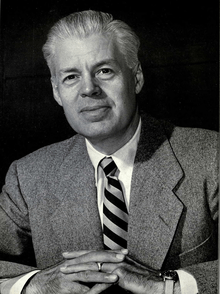Harlan Hatcher
| Harlan Hatcher | |
|---|---|
 Hatcher c. 1962 | |
| President of the University of Michigan | |
| Term | 1951 – 1967 |
| Predecessor | C. C. Little |
| Successor | Robben Wright Fleming |
| Born |
September 9, 1898 Ironton, Ohio |
| Died |
February 25, 1998 (aged 99) Ann Arbor, Michigan |
Harlan Henthorne Hatcher (September 9, 1898 – February 25, 1998)[1] served as the eighth President of the University of Michigan from 1951 to 1967.
Biography
Harlan Henthorne Hatcher was born on September 9, 1898, in Ironton, Ohio.[1][2] He received a B.A., an M.A. and a Ph.D. from Ohio State University.[2] He also attended the University of Chicago as a graduate student.[2]
He worked as a Professor of American Literature at Ohio State University, then as Dean of the College of Arts and Sciences in 1944, and as Vice President in 1948.[1][2] In 1951, he became the eighth President of the University of Michigan.[1] He helped expand the budget from $44.5 million to more than $186 million, and enrollment from 17,000 to 37,000.[1][2] He also established additional campuses in Flint and Dearborn.[1] In 1954, he condoned the hearings of the House Un-American Activities Committee and fired two faculty members for suspicions of Communism.[2] He stepped down in 1967.[1] In 1968, the Graduate Library was named after him.[1] He wrote three novels and several academic volumes.[2]
Bibliography
- Tunnel Hill (Bobbs-Merrill, 1931)
- Patterns of Wolfpen (Johns Creek, Pike County, Kentucky) (Bobbs-Merrill, 1934)
- Creating the Modern American Novel (1935)
- The Buckeye Country: A Pageant of Ohio (1940)
- The Ohio Guide (1940, editor)
- Modern American Dramas (1941)
- Lake Erie (1945)
- A Century of Iron and Men (1950)
- A Modern Repertory (1953)
- Johnny Appleseed: A Voice in the Wilderness, The Story of the Pioneer John Chapman (1953)
- A Pictoral History of the Great Lakes (1963)
- Versification of Robert Browning (1969)
- The Western Reserve: The Story of New Connecticut in Ohio
References
|